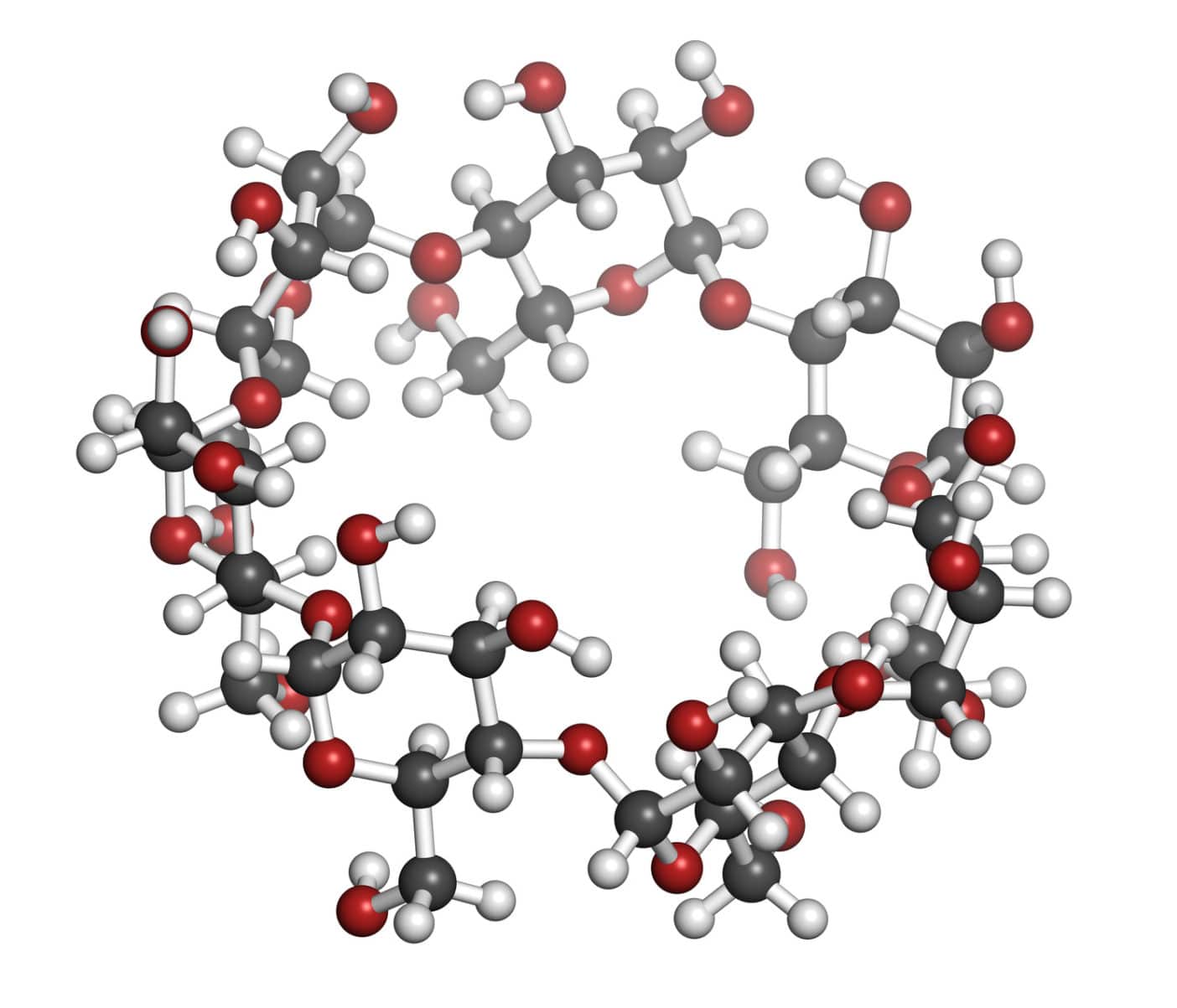Cyclodextrins

Cyclodextrins are compounds that belong to the oligosaccharides. They consist of several glucose molecules linked together in a ring. The structure of these glucose rings is always conical. Cyclodextrins are named differently depending on the number of glucose units: A ring of six glucose units is called alpha-cyclodextrin, with seven glucose molecules experts speak of beta-cyclodextrin, gamma-cyclodextrin is a unit of eight glucose molecules and delta-cyclodextrin is a unit of nine glucose molecules. Biotechnologically, cyclodextrins are mainly produced by the enzymatic degradation of starch (for example from maize or potatoes). In industry, cyclodextrins are regarded as true molecular sugar sachets. This is because they are able to trap lipophilic substances inside them, thereby changing their properties.
Advantages of using cyclodextrins
Cyclodextrins are used particularly frequently in the food, cosmetics and household goods industries. Among other things, they serve as stabilisers for various flavourings and ensure the effective elimination of unpleasant tastes or odours … and thus also improve the quality of food and luxury foods. Examples are the masking of bitter substances from grapefruit juices, coffee and tea as well as the masking of unpleasant odours in fish oil or garlic oil.
Another advantage is that flavours such as vanillin, menthol, cinnamon or orange oil in the form of cyclodextrin complexes are significantly less sensitive to light, oxygen, heat and humidity, which also increases their shelf life. In addition, new areas of application for cyclodextrins have been opening up in the food industry in recent years. Among other things, researchers are investigating the use of cyclodextrins to significantly reduce the cholesterol content of butter, cheese and eggs.
Cyclodextrins in cosmetics
Natural cyclodextrins are particularly suitable for use in cosmetics, where their main purpose is their stabilising effect. In anti-ageing products, for example, they are often used as stabilisers of linoleic acid, retinol and alpha-tocopherol. These substances, which sustainably protect the lipid molecules in the cell membranes from oxidative destruction and prevent premature skin ageing, are actually highly sensitive to high temperatures, atmospheric oxygen and UV radiation. However, the use of cyclodextrin complexes significantly increases the stability of preparations containing linoleic acid, retinol and alpha-tocopherol. In addition, the valuable excipients have another very positive effect: they indirectly prolong or intensify the effect by releasing the substances mentioned from their cavity in a controlled manner. Cyclodextrins can also encapsulate or mask unwanted odours in cosmetics. For example, odours that normally arise during the targeted self-tanning process of the skin with dihydroxyacetone or when bleaching the skin with substances such as glutathione. Cyclodextrins make the application of such products much more pleasant.
Beta-cyclodextrin is a food additive – E459
In foods, cyclodextrins form “starch cages” in which, for example, flavours can be “locked” so that they do not escape from the product (e.g. powdered drinks) during storage. At the same time, the flavourings remain protected from the detrimental influence of atmospheric oxygen. Some flavours are made bake-stable so that they only become apparent when consumed.
In grapefruit juice, coffee products etc. they mask the bitter flavour. Sweeteners lose their metallic, unpleasant aftertaste with E 459.
Controlled release of molecules
And that’s not all: the effect of release control can also be utilised in a variety of ways in cosmetics production. This works by packaging active ingredients in cyclodextrin microcapsules. In this way, researchers have been able to achieve an even and continuous release of menthol in after-sun products, which provides users with a very long-lasting and pleasant cooling effect. Cyclodextrins are also used in various acne preparations to achieve a continuous release and thus a lasting antibacterial effect.
Incidentally, cyclodextrins were first produced in pure form in 1891. Their function has been known for more than 50 years, but cyclodextrins and their applications have only been researched more intensively for around 30 years. Cyclodextrins are basically stable in alkaline solutions. However, they are broken down into the individual glucose units in acidic solutions.
We like to work with these cyclodextrin-based active ingredients:
| Tradename | INCI names | Supplier | Remarks | |
|---|---|---|---|---|
| Cavamax W6 Pharma | Cyclodextrin | Wacker Chemie AG | ||
| Cavamax W7 Pharma | Cyclodextrin | Wacker Chemie AG | ||
| Cavamax W8 Pharma | Cyclodextrin | Wacker Chemie AG | ||
| Melafresh T10-SLR | Cyclodextrin , Melaleuca Alternifolia (Tea Tree) Leaf O | Lucas Meyer Cosmetics | ||
| CC L-Carnitine 20% | Cyclodextrin , Carnitine | Rahn AG | ||
| CC Tea Tree Oil 15% | Cyclodextrin , Melaleuca Alternifolia (Tea Tree) Leaf Oil | Rahn AG | ||
| Phytodermina Lifting | Hydroxypropyl Cyclodextrin , Aqua | Rahn AG | ||
| CC Caffeine 50% | Caffeine , Cyclodextrin | Rahn AG | ||
| CC Menthol 50% | Menthol , Cyclodextrin | Rahn AG | ||
| CC Glycolic Acid 50% | Glycolic Acid , Cyclodextrin | Rahn AG | ||
| CC Idebenone 50% | Hydroxydecyl Ubiquinone , Cyclodextrin | Rahn AG | ||
| CC DHA 50% | Dihydroxyacetone , Cyclodextrin | Rahn AG | ||
| CC Salicylic Acid 50% | Salicylic Acid , Cyclodextrin | Rahn AG | ||
| Gen90S (1% Solution) | Genistein , Hydroxypropyl Cyclodextrin | Macrocare Tech Co. | ||
| Gen90Nano | Genistein , Hydroxypropyl Cyclodextrin | Macrocare Tech Co. | ||
| Proteasyl LS 8951 | Pisum Sativum (Pea) Extract , Cyclodextrin | BASF | ||
| LactoPro CLP | Lactobacillus/Milk Solids/Soybean Oil Ferment , Cyclodextrin | Lonza | ||
| White-Complex | Glycyrrhiza Glabra (Licorice) Root Extract , Hydroxypropyl Cyclodextrin , Pentylene Glycol | Vital-Chem Zhuhai Co. | ||
| Aqua Glabridin | Glycyrrhiza Glabra (Licorice) Root Extract , Hydroxypropyl Cyclodextrin , Pentylene Glycol | Vital-Chem Zhuhai Co. | ||
| OPSC - Olive Powder Squalane | Cyclodextrin , Squalane | EFP Biotek | ||
| OPSH - Olive Powder Squalane | Hydroxypropyl Cyclodextrin , Squalane | EFP Biotek | ||
| MPSH - Marine Powder Squalane | Hydroxypropyl Cyclodextrin , Squalane | EFP Biotek | ||
| MPSC - Marine Powder Squalane | Cyclodextrin , Squalane | EFP Biotek | ||
| Beauté by Roquette CD 100 | Cyclodextrin | Roquette | ||
| Beauté by Roquette CD 102 | Cyclodextrin | Roquette | ||
| Centella Asiatica Extract | Centella Asiatica Extract , Cyclodextrin | COSROMA |
The advantages at a glance
Stabilise, prolong or intensify the effect and prevent unpleasant odours: Cyclodextrins fulfil important and indispensable functions in cosmetic products. They are also waterproof and skin-friendly, and there are virtually no disadvantages. Only in the pharmaceutical industry is a little caution required. For example, cyclodextrins used in eye drops could be deposited in the cornea. However, this negative effect can also be eliminated by adjusting the concentration ratios. The compounds are therefore among the most effective and well-tolerated excipients, and not only in cosmetics.
Literature:
Cyclodextrin-based dermatological formulations: Dermopharmaceutical and cosmetic applications.
Ferreira L, Mascarenhas-Melo F, Rabaça S, Mathur A, Sharma A, Giram PS, Pawar KD, Rahdar A, Raza F, Veiga F, Mazzola PG, Paiva-Santos AC.Colloids Surf B Biointerfaces. 2023 Jan;221:113012
Christaki S, Spanidi E, Panagiotidou E, Athanasopoulou S, Kyriakoudi A, Mourtzinos I, Gardikis K.Pharmaceuticals (Basel). 2023 Sep 8;16(9):1274
Encapsulation of Fragrances in Micro- and Nano-Capsules, Polymeric Micelles, and Polymersomes.
Russell S, Bruns N.Macromol Rapid Commun. 2023 Aug;44(16):e2300120
Perinelli DR, Palmieri GF, Cespi M, Bonacucina G.Molecules. 2020 Dec 11;25(24):5878
Dahabra L, Broadberry G, Le Gresley A, Najlah M, Khoder M.Molecules. 2021 Mar 18;26(6):1698
Jakupović L, Bačić I, Jablan J, Marguí E, Marijan M, Inić S, Nižić Nodilo L, Hafner A, Zovko Končić M.Antioxidants (Basel). 2023 Apr 1;12(4):855
Messias MA, Ferreira SM, Tavares L, Santos L.Int J Mol Sci. 2023 Nov 1;24(21):15854
